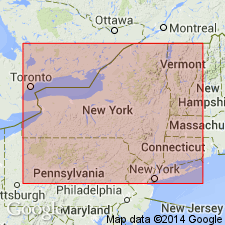
- Usage in publication:
-
- Curtice Road bed
- Modifications:
-
- First used
- Dominant lithology:
-
- Silt
- AAPG geologic province:
-
- Appalachian basin
Summary:
Overlying the Kashong Member of the Moscow Formation is a newly recognized but yet unnamed member of the Moscow, which extends throughout central NY, from at least Hamilton in the Chenango Valley to just west of Bristol Valley where it is absent due to erosional truncation. Member contains four distinctive marker beds: Barnes Gully (at the base), MEGASTROPHIA beds, Curtice Road bed, and the Geer Road bed. The Curtice Road bed is named for exposures along Curtice Road just north of Menteth Gully west of Canandaigua Lake. It is a resistant silty calcareous layer that caps small waterfalls and creek riffles in the Finger Lakes region. Thickness is 0.2 to 0.3 m. Bed is distinctly silty and grades eastward to a hard siltstone ledge. Shell-rich layers and lentils within this bed contain abundant large auloporid corals and pink strophomenid (brachiopods). Grades upward into a 3-m-thick interval referred to as LONGISPINA-MUCROSPIRIFER shales. Age is Middle Devonian (Givetian).
Source: GNU records (USGS DDS-6; Reston GNULEX).
For more information, please contact Nancy Stamm, Geologic Names Committee Secretary.
Asterisk (*) indicates published by U.S. Geological Survey authors.
"No current usage" (†) implies that a name has been abandoned or has fallen into disuse. Former usage and, if known, replacement name given in parentheses ( ).
Slash (/) indicates name conflicts with nomenclatural guidelines (CSN, 1933; ACSN, 1961, 1970; NACSN, 1983, 2005, 2021). May be explained within brackets ([ ]).

